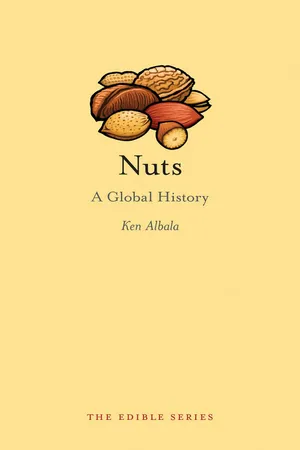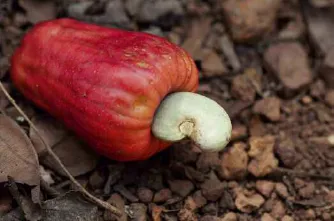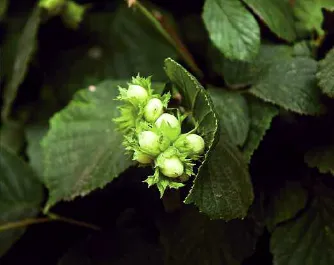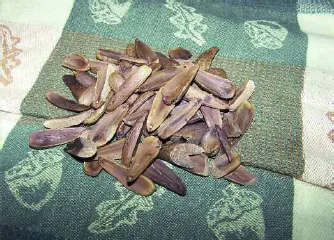![]()
1
What is a Nut?
Defining a nut botanically is not as simple as it sounds. It is technically a type of fruit with a hard shell. Linnaeus, the father of taxonomy, simply called it semen tectum epidermide ossea which means a seed with a hard, bony skin. But a nut is actually not a seed, like that found inside an apple or peach, which is why an almond is not a nut botanically. Neither are pine nuts or pistachios; all three are seeds. Peanuts are not nuts but legumes, and soy nuts, corn nuts and Grape Nuts are not nuts (the latter actually have nothing to do with either grapes or nuts). Surprisingly, the Brazil nut is a seed too; the coconut is a drupe, a kind of fruit in which the stone is derived from the ovary wall of the flower. Since Linnaeus’s time there has been so much division and confusion over the term ‘nut’ that some modern botanists simply avoid using it altogether.1
Dispensing with the penumbra of botanical classification, here is my concise definition of a nut, following the dictates of common culinary usage: nuts (noun, plural) are things that grow on trees, have hard shells and are edible. All things commonly referred to as nuts are discussed here.
Nuts must be, proverbially, hard to crack. They must also be crunchy rather than soft and gelatinous, like the inside of a peach pit, which would otherwise be a nut, like the close relative of the peach, the almond. Apricot kernels sometimes do pass as nuts, however, especially in China, but also in amaretti biscuits, which people assume are flavoured with almonds. The seeds of other plants come strikingly close as well, those of the cheerful sunflower especially; as much as I would love to add them to the rank of noble tree-borne nuts, in gastronomic terms they remain lowly seeds. There are so many other things that simply can’t be considered as culinary nuts, such as pumpkin seeds, tiger nuts (which are tubers) and lotus seeds.
Although there are hundreds of plant species that produce seeds which technically qualify as nuts, inedibility is grounds for immediate dismissal from coverage here. We must thus omit the horse chestnut, the beautiful buckeye and especially the nux vomica, from which strychnine is extracted. However, there are some poisonous nuts that we simply cannot avoid. Have you ever wondered why we never see cashews in the shell? The shell actually contains a powerful toxic irritant (the plant that produces cashews is in the poison ivy family). Bitter almonds are used in almond extract and pastries, though a few handfuls contain enough cyanide to kill a person.
Poisonous nuts aside, this book is not restricted to the common nuts like almonds, walnuts and pistachios, but includes some perfectly magnificent exotics, such as the mongongo of the San bushmen, and the areca, alias the betel nut, of Southeast Asia. There are many more nuts that deserve to be better known, plus a few that we often forget are nuts – like the nutmeg, despite its name, the cola nut and the coconut.
This book provides concise descriptions of the meaning of nuts throughout history and around the world; their uses in the kitchen and in maintaining health, and all the multifarious ways in which they have been processed into comestible goods, including oils, butters, nut-based milks and edible gums. As we shall see, nuts are eminently versatile and have been used in ways far beyond the out-of-hand snack that normally comes to mind. Because of their high fat content they serve as the base for high-calorie trail mixes and are excellent vegetarian fare as well, sometimes replicating dairy products perfectly: properly made fresh almond milk, for example, is a dead ringer for cow’s milk.
Many nuts are attached to or within a fruit, the flesh of which we rarely see for sale, though this too can be edible. The green flesh surrounding the unripe walnut, for example, can be pickled or soaked in alcohol to make the Italian elixir known as nocino. Immature almonds can be eaten whole, green fruit, shell and all. Even green unripe pistachios can be eaten. Cashews, too, have a red edible fruit, or ‘apple’, which is very fragile and is normally made into jam or an astringent juice. The original pineapple, from which the Caribbean fruit gets its name in English, is the green nut-bearing pine cone. On the other hand some nuts – true nuts like the acorn – have an exposed fruitless shell. Others are even more peculiar: the hazelnut wears a frilly green smock.
The cashew nut protrudes from the fruit like a sore thumb. Its shell is caustic.
Hazelnuts in their frilly green smocks.
Primitive Nuts
There are nuts that have been harvested as food for many millennia, and of course eaten by our animal relatives even longer, but they have resisted systematic cultivation. Some species, such as pecans, remained wild until fairly recently; Brazil nuts are still all harvested from the wild. This and their association with wild forests has given nuts a primitive appeal, as if these were the original foods of our ancient forebears before the advent of civilization. Nuts and berries are the original unprocessed foods, if you will; they are nature’s food, appropriate for vegetarians and fruitarians like Adam and Eve, because one can eat them without murdering a living organism. Like squirrels, we can store them for the winter, and they provide ample nutrition.
In many respects nuts have retained this wild association throughout history right to the present day, among health-food advocates, in raw-food diets and even among medical professionals who tout the benefits of nuts in preventing heart disease and other ailments. We seem to have a strong inner suspicion that these are the foods we evolved to eat, long before the introduction of cultivated grains and other farmed produce. ‘Going wild’ almost instantly conjures up a diet of nuts and berries.
Probably no other nut retains these associations as vividly as the acorn, which comes from trees of the genus Quercus. Unlike other nuts the majority of acorns require extensive processing to remove the bitter tannins within them, and this is done simply by pounding them and leaching them with water. The Native Americans of California subsisted on acorns, which explains why they had no need for agriculture.
Acorns
Acorns have been eaten by humans for millennia – mostly by those living in mountain wilds or by people who appreciated the oak’s remarkable fecundity and had no reason to plant grain crops, such as Native Americans. Europeans ate them too in prehistoric times and even after. The ancients imagined them to be among the first foods of humans, in the Golden Age, when humans lived in a simple vegetarian, peaceful paradise, freely gathering sweet acorns without true labour. The idyllic Arcadia was said to be inhabited by balanaphagoi – eaters of acorns – and no other food so vividly conjures up images of primitive simplicity. Real people of course ate them during famines, but they still seemed to be a pure and wholesome food. The ancient Greek poet Hesiod says of just and peaceful people that
The earth bears them victual in plenty, and on the mountains the oak bears acorns upon the top and bees in the midst. Their woolly sheep are laden with fleeces; their women bear children like their parents. They flourish continually with good things, and do not travel on ships, for the grain-giving earth bears them fruit.
The great Roman physician Galen tells a story of a famine during which country people ate the pigs that would normally have been kept fed on mast throughout the winter, then survived on the mast themselves for the rest of the winter. They boiled the acorns, baked them in hot ashes, and even made a soup with honey and milk. There is no suggestion that this constituted privation or hardship. Galen insists that acorns are just as nutritious as grains, and long ago the Arcadians subsisted on them.2
Dried California acorns after being shelled, before grinding, leaching and cooking.
Acorns are a true botanical nut, though they are rarely eaten anymore by humans.
Jean La Bruyère-Champier, the sixteenth-century food encyclopaedist, contends that before riotous luxury held sway men lived in caves, and that above all else which the Earth spontaneously bore as food, ‘humans especially ate from acorn bearing trees’, which furnished plentiful nourishment. In the pre-modern imagination acorns were the staple of the first palaeo diet.3
The commercial sale of acorns and even acorn flour is practically non-existent, and the few home producers who supply these online charge a hefty sum. If you really want to go wild, harvest acorns yourself. Make sure there are no little holes, which indicate that bugs live inside. White oak is the preferred species in the U.S. and in Europe it is the holm oak (Quercus ilex), and sometimes you can find trees that bear nuts which you can eat right off the tree, or just after a quick roasting in their shells. Most will need to be dried thoroughly in a warm oven, or in a dry place for up to a year. When they have dried, crack open and discard the shells, and pound the acorns in a big mortar or grinding rock until they are fine and floury. A blender or food processor can also be used for this purpose. Put the flour in a cloth bag, place this in a large bowl or bucket, and let water flow over the flour gently, pouring over the sides so that it is washed gradually. Continue until the flour is sweet. Put the flour on a baking sheet and let it dry thoroughly in the oven, set at 50°C (120°F) or so.
Use the acorn flour as you would any non-glutinous flour, for pancakes, muffins and even cakes. A little mixed with bread flour will give risen bread a rich, nutty flavour. The proper way to cook acorn flour for the primitivist would be to heat up some volcanic rocks in a fire, then dump them in a tightly woven basket containing the acorn flour and water. This is then stirred until a smooth porridge is achieved, the rocks are removed and the porridge is eaten. My personal favourite, however, is the acorn crêpe – the instructions for making it are in the recipe section.
Brazil Nuts
Half a world away from the acorn, tropical Brazil nuts are the nuts of romance – not the elegant sophisticated kind of romance, but wild jungle love, deep in the heart of the Amazon. The Brazil nut is not a nut but a seed that grows in two rows like orange segments inside a heavy, round pod, in form and function not unlike a cannon ball, as those who have been struck by one plummeting hundreds of feet onto their heads can readily attest. Brazil nuts come not only from Brazil itself, but from across the tropical Amazon Basin, where they are collected by native peoples. This, no doubt, is the reason for the primitive association, but it may perhaps also be because despite the best efforts, Brazil nuts are not a cultivated food. There are few other plants that are commercially harvested from the wild on such a scale. The wild state of the massive trees (Bertholletia excelsa) that bear the nuts is due to the curious mode of propagation. This can only be performed by a special orchid bee that bears a prodigious tongue with which to probe the curvaceous depths of the flowers and pollinate them. The pod containing the nuts is so hard that it must be smashed with an axe, and the nuts likewise resist the most powerful nutcrackers, their odd three-sid...





